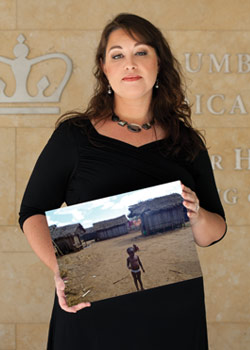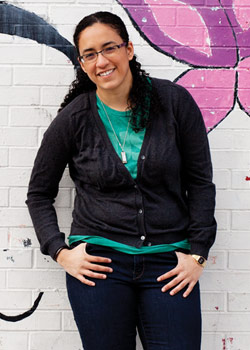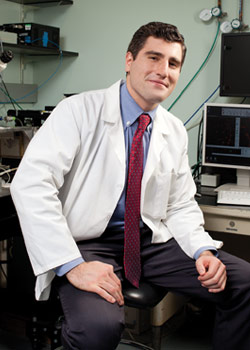Inaugural Scholarly Projects
to Home
The Class of 2013 is the first to graduate from P&S under a new curriculum that includes four months of protected time to complete a scholarly project. Students were paired with faculty mentors to immerse themselves in an area of medical practice or research with a goal of developing an individual professional or intellectual passion. Scholarly projects are required of all graduates, although students pursuing dual degrees may apply their second degree toward the scholarly project requirement, and students who take a year off for research also may opt to apply their research to the requirement.
“Students completing the scholarly project have the opportunity to ask innovative questions, deepen their experience of medicine, and contribute to the academic environment,” says Jonathan Amiel’07, assistant dean for curricular affairs, who oversees the scholarly project program.
Students selected projects from among six tracks: basic science, clinical research, global health, narrative and social medicine, medical education, and population health. They submitted a written summary of their work, which was reviewed and evaluated by faculty against track-specific standards.
Four projects, representing four of the six tracks, are described below.

Madagascar: Giving the Smallest a Chance to Grow Global Health Scholarly Project of Kim Stanford’13
Project title:
“Exploring Interventions to Reduce Maternal and Child Malnutrition in Madagascar”
Mentor:
Martin Malachovsky, MD
Global health track director:
Stephen Nicholas, MD
Kim Stanford’13 is no stranger to travel, logging visits to more than 60 countries. She combined her love of travel with her scholarly project to spend three months last summer working with a medical nongovernmental organization in Madagascar, which has the world’s fifth highest rate of child stunting due to malnutrition. “The country has made essentially no progress towards eradicating malnutrition in the past 20 years,” Ms. Stanford writes in her project summary, and as many as half of all deaths of children under age 5 are related to malnutrition.
Ms. Stanford used her project to compare malnutrition in two regions of the country and to suggest strategies for helping the NGO, Maventy Health International, expand its efforts from the northern region into the southern region.
The southern part of Madagascar is more challenging for relief efforts because it has the highest prevalence of poverty in the country, it sits in a desert suffering from a long-term drought, and 60 percent of women have no education, making it difficult to depend on maternal education strategies that have worked elsewhere to improve childhood nutrition. Residents rely on foods with low nutritional value, spending 56 percent of their food budget, on average, on simple starches that provide calories but are not sufficient for healthy growth in children.
“Although governmental guidelines are in place for the treatment of malnutrition, a major problem that interferes greatly with the efficacy of the outpatient treatment regimen is the propensity of mothers to sell their packets of PlumpyNut, a nut-based protein and vitamin concoction designed for severely malnourished children, at the market rather than feeding them to their malnourished children,” says Ms. Stanford. “There is a widespread belief among mothers that rice and rice water are the most appropriate food for children. Also, fathers dominate the household and physical abuse is widespread, thus mothers may feel that their priority is to provide for their husbands before their children. These beliefs and practices would at least partially explain a failure to improve even amongst children who faithfully attend screening events and receive PlumpyNut supplementation weekly.”
Other challenges include the lack of a standardized record-keeping system to track all children and the widespread geographic distribution of families throughout the countryside, making it difficult for families that live hours from any kind of health care.
Ms. Stanford’s paper outlines three broad strategies that could be implemented in the southern area of the country:
• Directly observed therapy. Rather than getting PlumpyNut once a week, children would be required to come to the office and eat it in the presence of staff. “This might dissuade some families from participating but likely would result in a greater number of children receiving the nutritional supplementation they require.”
• Expand on the status quo. The model currently in place includes centralized screenings, distribution of PlumpyNut only to “severely” malnourished children who attend screenings, and tracking of hospitalized children. Ms. Stanford recommends expanding screening and interventional programs into several villages. “This would potentially reach children who are being missed and also begin to identify and address the problems faced by children who are malnourished but do not yet qualify for hospitalization.” She also suggested modifications to the electronic record system used to track malnourished children and suggested narrowing the focus of screenings and interventions to children 6 months to 23 months old, the time when children have been shown to be hardest hit by malnutrition so interventions would have the highest potential long-term benefit. (Programs now screen and treat all children under age 5.)
• Attack the problem from a new angle. “Some interventions not directly nutritional in nature have been shown to result in enormous impact on children’s health with extraordinarily high benefit-to-cost ratios,” says Ms. Stanford. These include deworming, distribution of iodized salt to pregnant mothers, and iron supplementation. “These kinds of indirect interventions may feel somewhat less satisfying to volunteers or to the families receiving them, as it is not as immediately obvious to someone not familiar with the literature that these may be as good as or better than food handouts in combating malnutrition.”
Ms. Stanford’s work was supported through the new Sara and Arnold P. Friedman Awards program, which provides funding to allow students to pursue projects abroad and to travel to meetings to present their work. The Friedman Awards were created by Carol Ludwig’74 in honor of her parents. Her father, an internationally prominent neurologist specializing in migraine and past president of the American Board of Psychiatry and Neurology, was a member of the P&S faculty from 1944 through 1967.

Resources to Teach Cultural Competency Medical Education Scholarly Project of Camila Mateo’13
Project title:
“Teaching Cultural Competency Through Community-Academic Partnership for Undergraduate Medical Students: A Digital Perspective”
Mentor:
Dodi Meyer, MD
Medical education track director:
Marc Dickstein, MD
Not too many years ago, new medical students went on a walking tour of Washington Heights and Inwood—WaHI—to familiarize themselves with all the neighborhood offers. How old school. Today, new students can take a virtual tour to learn about Dominican culture, explore health indicators, discover historical landmarks, and find local resources that will help students enrich their interactions with patients.
Camila Mateo’13 is one of two students in the class with Dominican roots. The daughter of two pediatricians, Ms. Mateo grew up in Florida and chose P&S largely because of the chance to live in Washington Heights.
Questions from her fellow students at first centered on food and entertainment in the neighborhood, but the nature of the questions changed when the class entered its second year and students started caring for patients. “There is a definite cultural distance between the university and the community, and my classmates were facing those issues on the wards for the first time,” she says. “They were frustrated and would ask me questions such as, how come my Dominican patients are lost to follow-up for four months? I’d explain that Dominican culture is profoundly transnational and, for cultural and financial reasons, many people live part of the year in New York and the other part in the DR.”
When the time came for Ms. Mateo to pick a scholarly project, she thought about what she could do to help future P&S students navigate cultural issues in the neighborhood and in the clinic. The result was a website called VIDA! (for Virtual Introduction to Dominican Americans in Washington Heights and Inwood). The site can be found at http://vida.wikischolars.columbia.edu/.
The virtual tour starts with information about the historical significance of the neighborhood but quickly goes into details about common beliefs and characteristics of Dominican Americans.
“I wanted to create a safe space where people could learn about their neighbors, learn about their patients, and not be afraid to ask questions,” says Ms. Mateo. “At the same time, I don’t want people to feel they are on a cultural safari, which was one of the complaints of the walking tour.”
To prepare the site, Ms. Mateo visited many of the neighborhood’s community organizations, including Alianza Dominicana and the ARC XVI Senior Center, for advice. Her classmates helped her understand what kinds of information students need.
Launched in early February 2013, VIDA! includes a feedback survey that allows users to suggest improvements.
Ms. Mateo hopes the website also shows everyone how much the community has to offer. “We often think: How can we make Washington Heights and Inwood better? We look at the community in terms of its deficits,” she says. “But what if we started looking at its assets? What does this community already have that we’re missing because we’re not looking hard enough?”

Readmission as a Metric for Quality Clinical Research Scholarly Project of Irmina Gawlas’13
Project title:
“Readmission After Pancreatic Resection is Not an Appropriate Indicator of Quality”
Mentor:
John Allendorf, MD
Clinical research track director:
Henry Spotnitz, MD
Health care reform includes new mandates for reporting readmission rates for certain conditions, suggesting that the quality of medical and surgical care can be measured by hospital readmission.
The Center for Medicare and Medicaid Services requires reporting of 30-day readmission rates for pneumonia, congestive heart failure, and myocardial infarction, and the Affordable Care Act provides for regulations that affect payment if a patient is readmitted because of a problem that could have been reasonably prevented “through the application of evidence-based guidelines.” These regulations, says Irmina Gawlas’13, are being extended to postoperative complications. “Hospitals will not be reimbursed for the additional costs associated with surgical site infections after coronary artery bypass, bariatric surgery, and certain orthopedic procedures.”
In anticipation that guidelines will be applied to complications and readmissions related to pancreatic surgery, Ms. Gawlas and the research team examined NewYork-Presbyterian’s readmission rates after pancreatic resection to assess factors that predict readmission. She co-authored an article in Annals of Surgical Oncology about the research.
The team reviewed 787 pancreatic resections performed at NewYork-Presbyterian between 2006 and 2010. The 30-day readmission rate was 11.6 percent with the most common reason for readmission being leaks, fistulas, abscesses, and wound infections. Those accounted for 45.1 percent of readmissions. Other readmissions were caused by delayed gastric emptying (12.1 percent), venous thrombosis (7.7 percent), and gastrointestinal bleeding (7.7 percent).
“We found the vast majority of readmissions after pancreatic resection were to manage complications related to the operation and were not due to poor coordination of care or poor discharge planning,” says Ms. Gawlas in the Annals of Surgical Oncology paper. “We find readmissions after pancreatic resections to be common, multifactorial, and not readily predictable. Our data do not support previous suggestions that more cautious discharge or increased referral for skilled services could decrease readmission rates. In fact, we found that the majority of readmissions were for known and not unexpected complications of these complex procedures. The rates of such complications are widely reported to occur in approximately 50 percent of cases and have not been shown to be preventable by any perioperative measures.
“We conclude that readmissions after pancreatic surgery are a reflection of the complexity of these procedures and represent an unfortunate but by and large inevitable part of the postoperative course for an unpredictable subset of patients. Thus, until there is consensus on evidence-based methods to decrease complication rate, we cannot support the use of readmission as a quality indicator after pancreatic surgery.”
Ms. Gawlas’ faculty co-authors of the paper were Monica Sethi’12, Megan Winner, MD, Irene Epelboym, MD, James L. Lee, MD, Beth A. Schrope, MD, PhD, John A. Chabot, MD, and John D. Allendorf’97.

Using Stem Cells to Deliver New Healthy Mitochondria to Damaged Lung Cells Basic Science Scholarly Project of Robert Rogers’13
Project title:
“Mitochondrial Transfer from Mesenchymal Stem Cells to Human Alveolar Epithelial Cells in vitro”
Mentor:
Jahar Bhattacharya, MD, PhD
Basic science track director:
Richard Kessin, PhD
Research over the past 15 years has shown that a major factor in lung failure during sepsis is the shutdown of the lung’s mitochondria. And despite dozens of animal experiments targeting mitochondrial pathways, no medication has proved successful in treating patients with acute respiratory distress syndrome, or ARDS, which often complicates sepsis.
“The sheer variety of ways in which sepsis induces mitochondrial dysfunction suggests that an intervention focused on correcting just one of those pathways is unlikely to have clinical benefit,” says Robert Rogers’13, who spent most of 2012 in the lab of Jahar Bhattacharya, MD, PhD, researching new ways to improve mitochondrial function.
The best way to “fix” the dysfunctional mitochondria in ARDS may be simply to provide lung cells with fresh, healthy organelles. “Delivery of whole mitochondria to cells is a big challenge, but mesenchymal stem cells may be the perfect delivery vehicle,” says Mr. Rogers in the capstone paper he submitted for his scholarly project.
That stem cells can donate their mitochondria to other cells is a newly discovered phenomenon, observed for the first time in vitro in 2006. And based on recent work in Dr. Bhattacharya’s lab, the transfer of mitochondria appears to be a major reason why mesenchymal stem cells, when delivered to lungs, help animals with ARDS recover.
Because Dr. Bhattacharya’s studies found that stem cells donate mitochondria only to damaged lung cells, learning what signal stimulates transfer could be important in optimizing a stem cell therapy for ARDS.
To answer this question, a reliable in vitro model of mitochondria transfer from stem cells to lung cells must be established. Mr. Rogers set out to create such a system using mouse stem cells and human lung cells.
His work—like much of medical research—opened up more questions. Even though mitochondrial transfer is thought to occur at a low rate in uninjured cells, Mr. Rogers’ results initially suggested it was very common, with more than 90 percent of lung cells receiving mitochondria from neighboring stem cells.
Yet what Mr. Rogers measured in these experiments was not mitochondria, but a dye meant to track mitochondria. “I am not confident that all these mitochondria are transferred during these experiments but maybe the dye is diffusing across cell membranes. It is not an ideal mitochondrial label.”
At the end of his time in the lab, Mr. Rogers turned to another method of tracking mitochondria, this time genetically modifying a mitochondrial protein with a red fluorescent marker. With a red marker firmly attached to the mitochondria, this method should resolve the questions his first experiments posed: Is mitochondrial donation really so high? If so, are the cells used in the assay—mouse stem cells and human lung cells initially derived from human adenocarcinoma—the reason behind the high donation rate?
Mr. Rogers’ careful observations of his cells also may suggest that in addition to reacting to a signal from the injured lung cells, mesenchymal stem cells may pick up signals from the bacterial toxin behind many cases of ARDS.
The editor acknowledges the help of Andrew Vagelos in coordinating the selection of student projects for this article. Read about more scholarly projects in the 2012 P&S annual report, available online at http://bit.ly/psannualreport.
- Log in to post comments


